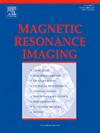时间依赖性扩散MRI和动力学异质性作为3.0 t乳腺MRI诊断可疑乳腺病变的潜在成像生物标志物。
IF 2.1
4区 医学
Q2 RADIOLOGY, NUCLEAR MEDICINE & MEDICAL IMAGING
引用次数: 0
摘要
目的:本研究旨在评估基于时间依赖性扩散磁共振成像(td-dMRI)和基于动态对比增强MRI (DCE-MRI)的动力学异质性在鉴别可疑乳房病变中的诊断效果(分类为乳腺成像报告和数据系统4或5)。方法:本前瞻性研究纳入了51名患有可疑乳房病变的女性,她们术前进行了乳房MRI检查,包括DCE-MRI和td-dMRI。利用MATLAB和SPM软件从DCE序列中提取6个动力学参数,即峰值、持续、平台、冲刷分量、优势曲线类型和异质性。采用JOINT模型对td-dMRI数据进行分析,得到5个微观结构参数和50ms时的表观扩散系数(ADC50ms)。使用卡方检验或Fisher精确检验和Mann-Whitney U检验来比较乳腺良恶性病变的这些参数。采用前向逐步协变量选择进行单因素和多因素logistic回归分析,以确定重要的临床和放射学变量。采用受试者工作特征曲线和逻辑回归分析评估差异诊断性能。结果:对于td- dmri衍生的参数,乳腺恶性病变的鳍和细胞度值明显高于良性病变(P = 0.001),恶性病变的P50ms明显低于良性病变(P = 0.001)。在动力学异质性分析中,恶性病变的洗脱分量高于良性病变(P = 0.003)。结合显著td-dMRI和动力学异质性参数,曲线下面积(AUC)值为0.875,准确率为82.69%,灵敏度为86.11%,特异性为75.00%,阳性预测值(PPV)为88.57%,阴性预测值(NPV)为70.59%。值得注意的是,边缘和动态模式成为乳腺恶性病变的独立预测因子(P分别= 0.019和0.006)。此外,结合这两个临床放射学特征进一步提高了诊断的准确性,AUC为0.969,准确性、敏感性、特异性、PPV和NPV分别提高到90.38%、86.11%、100%、100%和76.19%。结论:动力学异质性和td- dmri衍生参数是鉴别可疑乳腺病变的潜在非侵入性生物标志物。本文章由计算机程序翻译,如有差异,请以英文原文为准。
Time-dependent diffusion MRI and kinetic heterogeneity as potential imaging biomarkers for diagnosing suspicious breast lesions with 3.0-T breast MRI
Purpose
This study aimed to evaluate the diagnostic efficacy of time-dependent diffusion magnetic resonance imaging (td-dMRI) and dynamic contrast-enhanced MRI (DCE-MRI)-based kinetic heterogeneity in differentiating suspicious breast lesions (categorised as Breast Imaging Reporting and Data System 4 or 5).
Methods
This prospective study included 51 females with suspicious breast lesions who underwent preoperative breast MRI, including DCE-MRI and td-dMRI. Six kinetic parameters, namely peak, persistent, plateau, washout component, predominant curve type, and heterogeneity, were extracted from the DCE series using MATLAB and SPM software. The td-dMRI data were analysed using the JOINT model to obtain five microstructural parameters and apparent diffusion coefficient at 50 ms (ADC50ms). Chi-square or Fisher's exact test and the Mann–Whitney U test were used to compare these parameters between benign and malignant breast lesions. Univariate and multivariate logistic regression analyses with forward stepwise covariate selection were performed to identify significant clinical and radiologic variables. Differential diagnostic performance was evaluated using receiver operating characteristic curves and logistic regression analyses.
Results
For td-dMRI-derived parameters, the values of fin and cellularity were significantly higher in malignant breast lesions compared to benign lesions (P = 0.001 and P<0.001, respectively), while ADC50ms was significantly lower in malignant lesions (P = 0.001). In the kinetic heterogeneity analysis, the washout component was higher in malignant lesions compared to benign lesions (P = 0.003). When combining significant td-dMRI and kinetic heterogeneity parameters, the area under the curve (AUC) value was 0.875, with an accuracy, sensitivity, specificity, positive predictive value (PPV), and negative predictive value (NPV) of 82.69 %, 86.11 %, 75.00 %, 88.57 %, and 70.59 %, respectively. Notably, margin and kinetic pattern emerged as independent predictors of malignant breast lesions (P = 0.019 and 0.006, respectively). Furthermore, incorporating these two clinical-radiologic characteristics further enhanced diagnostic accuracy, yielding an AUC of 0.969, with accuracy, sensitivity, specificity, PPV, and NPV improving to 90.38 %, 86.11 %, 100 %, 100 %, and 76.19 %, respectively.
Conclusions
Kinetic heterogeneity- and td-dMRI-derived parameters are potentially non-invasive biomarkers for distinguishing suspicious breast lesions.
求助全文
通过发布文献求助,成功后即可免费获取论文全文。
去求助
来源期刊

Magnetic resonance imaging
医学-核医学
CiteScore
4.70
自引率
4.00%
发文量
194
审稿时长
83 days
期刊介绍:
Magnetic Resonance Imaging (MRI) is the first international multidisciplinary journal encompassing physical, life, and clinical science investigations as they relate to the development and use of magnetic resonance imaging. MRI is dedicated to both basic research, technological innovation and applications, providing a single forum for communication among radiologists, physicists, chemists, biochemists, biologists, engineers, internists, pathologists, physiologists, computer scientists, and mathematicians.
 求助内容:
求助内容: 应助结果提醒方式:
应助结果提醒方式:


